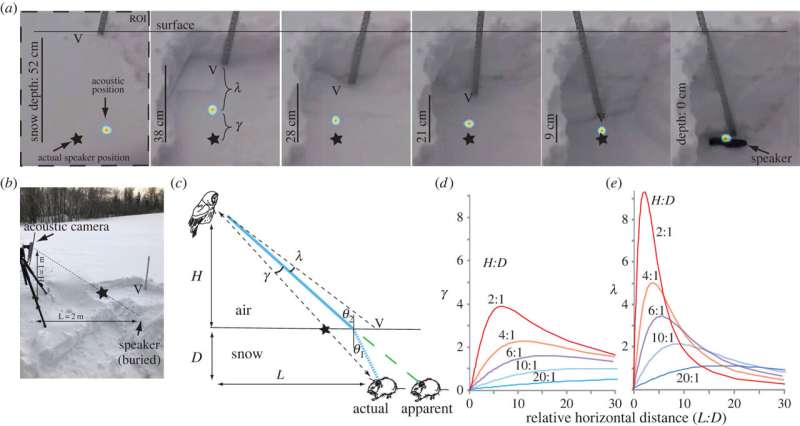How great gray owls find prey under deep blankets of snow

A trio of researchers from the University of California, Discover Owls and the University of Washington has discovered how great gray owls are able to find and capture voles under two feet of snow. In their paper published in Proceedings of the Royal Society B, Christopher Clark, James Duncan and Robert Dougherty describe using acoustic cameras to spatially locate sound sources under the snow.
Prior research has shown that great gray owls are able to detect the presence of prey, such as rabbits and voles, under deep blankets of snow. Once found, the owls are able to swoop down and push their feet and legs through the snow to capture their prey. In this new effort, the researchers sought to figure out how they do it.
The work involved venturing into the forests of Manitoba, Canada, which is covered every winter by a thick blanket of snow. They looked for, and found, plunge holes, evidence of owls plunging into the snow and grabbing prey—in this case, mostly voles. They then dug similar holes next to those they found and buried speakers under the snow.
They set up acoustic cameras that were capable of recording a wide range of sound in the vicinity of the buried speakers. The researchers then played sounds from the speakers and measured what was audible through the snow using the microphones on the acoustic cameras. As they did so, they slowly removed layers of snow covering the speakers to learn more about which sounds were able to penetrate which amounts of snow.
They found that white noise was able to penetrate thin layers of snow, but only very low-frequency noise was able to penetrate deep snow. The researchers note that great gray owls have large, round faces with feathers that reflect sound, making it possible for them to hear low-frequency sounds, such as those made by voles digging through snow.
The researchers also noted that the birds generally circled over an intended target for a few seconds before diving—a means, the researchers noted, for overcoming problems with sound refracting as it passed through the snow.
More information:
Christopher J. Clark et al, Great Gray Owls hunting voles under snow hover to defeat an acoustic mirage, Proceedings of the Royal Society B: Biological Sciences (2022). DOI: 10.1098/rspb.2022.1164
© 2022 Science X Network
Citation:
How great gray owls find prey under deep blankets of snow (2022, November 23)
retrieved 23 November 2022
from https://phys.org/news/2022-11-great-gray-owls-prey-deep.html
This document is subject to copyright. Apart from any fair dealing for the purpose of private study or research, no
part may be reproduced without the written permission. The content is provided for information purposes only.
For all the latest Science News Click Here
For the latest news and updates, follow us on Google News.

